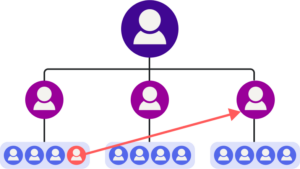Communication Flow
communication flows
Patterns of communication involving different types of employees and different functional parts of an organization are called flows.
Downward Communication
When leaders and managers share information with lower-level employees, it’s called downward, or top-down communication. In other words, communication from superiors to subordinates in a chain of command is a downward communication. This communication flow is used by the managers to transmit work-related information to the employees at lower levels. Ensuring effective downward communication isn’t always easy. Differences in experience, knowledge, levels of authority, and status make it possible that the sender and recipient do not share the same assumptions or understanding of context, which can result in messages being misunderstood or misinterpreted. Creating clearly worded, unambiguous communications and maintaining a respectful tone can facilitate effective downward communication.
Upward Communication
Upward communication is the transmission of information from lower levels of an organization to higher ones; the most common situation is employees communicating with managers. Managers who encourage upward communication foster cooperation, gain support, and reduce frustration among their employees. The content of such communication can include requests, estimations, proposals, complaints, appeals, reports, and any other information directed from subordinates to superiors. Upward communication is often made in response to downward communication; for instance, when employees answer a question from their manager. In this respect, upward communication is a good measure of whether a company’s downward communication is effective.
The availability of communication channels affects employees’ overall satisfaction with upward communication. For example, an open-door policy sends the signal to employees that the manager welcomes impromptu conversations and other communication. This is likely to make employees feel satisfied with their level of access to channels of upward communication and less apprehensive about communicating with their superiors. For management, upward communication is an important source of information that can inform business decisions. It helps to alert management of new developments, levels of performance, and other issues that may require their attention.
Horizontal Communication
Horizontal communication, also called lateral communication, involves the flow of messages between individuals and groups on the same level of an organization, as opposed to up or down. Sharing information, solving problems, and collaborating horizontally is often more timely, direct, and efficient than up or down communication, since it occurs directly between people working in the same environment. Communication within a team is an example of horizontal communication; members coordinate tasks, work together, and resolve conflicts. Horizontal communication occurs formally in meetings, presentations, and formal electronic communication, and informally in other, more casual exchanges within the office.
When there are differences in style, personality, or roles among coworkers, horizontal communication may not run smoothly. According to Professor Michael Papa, horizontal communication problems can occur because of territoriality, rivalry, specialization, and simple lack of motivation. Territoriality occurs when members of an organization regard other people’s involvement in their area as inappropriate or unwelcome. Rivalry between individuals or teams can make people reluctant to cooperate and share information. Specialization is a problem that occurs when there is a lack of uniform knowledge or vocabulary within or between departments. Finally, horizontal communication often fails simply because organization members are unwilling to expend the additional effort needed to reach out beyond their immediate team.
Diagonal Communication

Diagonal communication is the sharing of information among different structural levels within a business and between different functional areas. This kind of communication flow is increasingly the norm in organizations (in the same way that cross-functional teams are becoming more common), since it can maximize the efficiency of information exchange. The shortest distance between two points is a straight line. Diagonal communication routes are the straight lines that speed communications directly to their recipients, at the moment communication is necessary. Communications that zigzag along horizontal and vertical routes, on the other hand, are vulnerable to the schedules and availability of the individuals who reside at each level.
External Communication
Another type of communication flow is external, when an organization communicates with people or organizations outside the business. Recipients of external communication include customers, lawmakers, suppliers, and other community stakeholders. External communication is often handled by marketing and sales. Annual reports, press releases, product promotions, financial reports are all examples of external communication.